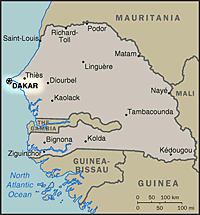|
.
|
|

Today, President Clinton spends his last day in Africa in Senegal. During
the morning, the President participates in a
panel discussion with
democracy and human rights activists. Later in the day, the President
visits Goree Island.
Panel Discussion with Democracy and Human Rights Activists
In Dakar, the President convenes a panel of leading democracy and human
rights activists from around Africa for an in-depth discussion about how to
strengthen the elements of civil society and promote good governance. A
central element of the President's trip to Africa has been engaging the
African people in ways to protect and advance human rights and democratic
participation. The issues of promoting human rights, women's emancipation,
credible judiciary and freedom of the press were key items on the agenda of
the Entebbe Summit and throughout the President's bilateral meetings.
Goree Island
The final stop on the President and First Lady's trip to Africa is a tour
of the Slave House at Goree Island. Located just two miles off the coast
of Dakar, Goree [GOR-ray] Island (meaning "good harbor") stands as one of
the symbols of Africa's past and its links to the Americas. Goree served
as a transit point for many West African slaves en route to the New World.
The island was also the site of the first U.S. Consulate in West Africa,
established in 1883. Similar slave houses dot west Africa's coast. UNESCO
has declared Goree a "World Heritage Site."
Goree Island is home to about 1,300 Senegalese. The Portuguese explorer
Bartholemeu Dias in 1444 is credited with the first European sighting of
the island, in 1444. The Dutch purchased it from the local chief in 1586,
and named the island Goree. The French took control of Goree in the 17th
century, and it eventually became the principal site for French-flag
slavers and merchants traveling along the West African coast. After the
French abolished slavery in 1856 in their overseas possessions, Goree
became an outpost for policing the seas and later a base for French
colonial expansion into West Africa.
The Slave House (Maison des Esclaves) is the only remaining site on Goree
Island where Africans were brought to be loaded onto ships bound for the
Americas. Built in 1776 by a wealthy slave-trading family, it now serves
as a museum and memorial to the many slaves who were sold into a life of
bondage in the Americas.
The upper floor consisted of residential quarters for slave traders.
Slaves held in the cells below were weighed, chained and inhumanly cramped
into the small cell areas, before departing through the "door of no return"
(the small entrance way leading to the slave ships).
The President is shown the Slave House by curator Joseph Ndiaye [in-JAI],
whose personal commitment and perseverance are responsible for the
maintenance of the museum. He has personally shown the house and described
its past to many world leaders and to the First Lady when she visited in
March 1997.
|

![]()

![]()